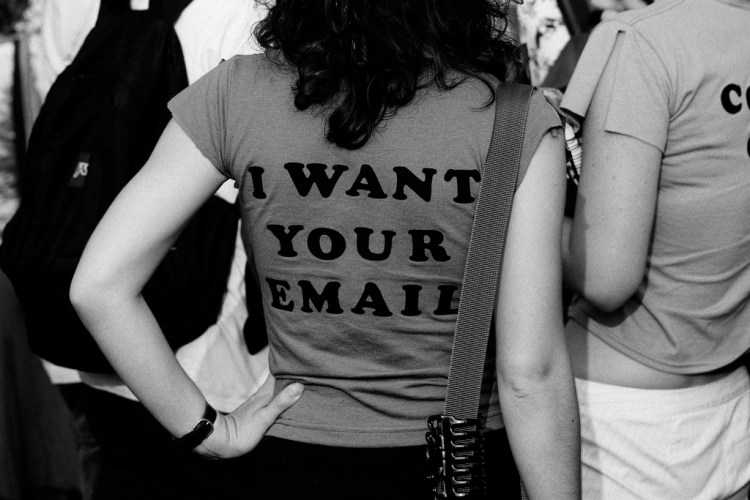“There was a day when I looked up and realized that I had become someone who professionally replied to email, and who wrote as a hobby.”
Substitute “wrote” for whatever you’re supposed to be doing with your life, and this sentiment — as expressed in Neil Gaiman’s brilliant address to the University of the Arts Philadelphia — will probably resonate.
In fact, a 2012 McKinsey survey found that 28 percent of the average working day is taken up with email.
An ugly hybrid
We may be abandoning Gmail for chats on Facebook Messenger (500 million monthly users) and WhatsApp (600 million monthly users), but for most of us, email remains the mainstay of our working lives — and it’s a mainstay we hate.
Never the most elegant of tools, email has in recent years come to seem a deep, dark oubliette of pain compared to the swift, bright streams of social media.
Even its value as a digital paper trail has been undermined by ‘sent on my iPhone’ disclaimers — which apparently absolve everything from bad grammar to bad decisions — and the trend for passive-aggressive, responsibility-shirking mass-cc’ing.
Then there’s the cross-pollination of social media idioms; I don’t know about you, but I find it hard to maintain my authority once I’ve unwittingly sent a client a kiss.
Seriously sticky
Nevertheless, we continue to feed this ugly gremlin, however many fluffier and friendlier creatures (Yammer, Asana) the tech industry throws our way.
This is deeply perplexing to over-achieving entrepreneurs who would rather ingest high fructose corn syrup than open Outlook. Ever sexier collaboration tools continue to launch, with this year’s notables including Slack and Mailcloud.
I wish them luck, I really do; I long to extricate myself from email’s extraordinarily sticky web.
But I also suspect that these prospective email-slayers will follow the pattern set by Google Wave back in 2009: utopian high-five hype followed by rapid disillusionment, as users realise that they’re been spending more time dicking around with fancy colour-tags than nailing their to-do list.
Why? Of course, there’s the fact that most organizations find it hard enough to change their toilet paper supplier without a crisis, let alone shift their entire communications system. But the main problem is that email is not ineffective because of the nature of the technology, but because of the nature of the people using it.
Changing attitudes not apps
“Email is an open standard and universally accessible to anyone, anywhere in the world,” says Gordon Magione, founder of Tipbit, the startup that promises to return email to “killer app status.”
“Whether it involves a sign-up form or customer service, every web service is dependent on email — the only system in the world where a user can send a message regardless of infrastructure,” Magione writes. “And email is private and secure. It holds your data and a majority of your very personal information. There is so much more control with where and how you manage your information.”
Most of the things that annoy us about email — rambling, unactionable chains; all-hours interruption; impenetrable Powerpoints clogging up our server — are a result of bad working practices, not bad tech practices, and no amount of pastel-tinted streams with responsive tick-boxes are going to shift that.
Emails frustrates because it is a window onto both our and others’ procrastination, insecurity, one-upmanship, laziness and lack of self-control – not because its file size restrictions force us to use Dropbox once in a while.
In fact, many of the alternatives threaten to intensify email-based irritants.
Collaboration isn’t always the answer
The conversational ‘marketplace’ feel of collaborative platforms often impels people to be seen to contribute, whether they have anything of value to add or not.
This focus on visibility can reward time spent on the system rather than time spent doing work. Integration with other social platforms can blur personal/professional boundaries further and an ‘always-on’ stream of global content can make it even harder to switch off.
“It’s not wrong to offer new ways to collaborate within an office environment, but to try and replace email with these types of tools entirely is a recipe for disaster,” Mangione agrees.
Email is still necessary, especially in business, when communicating externally to partners, clients and beyond.
When discussing confidential business information, it’s certainly not going to be shared in a casual chat session, but rather over email where information and who sees it can be more controlled.
Email is most certainly rubbish at collaboration. It’s based on dialogue, but it’s not social; and it’s exactly this hyrbid status that makes it so valuable. Because we still don’t (or shouldn’t) expect our emails to be answered instantly, it allows room for more careful composition and thought.
So rather than adding another layer of digital into your work life, why not try rehabilitating the way you work.
Create clear folders and unsubscribe from your junk. Send short, clear, emails which are a record of actions that came out of real conversations over the phone or face to face.
Allocate times in your day to check emails, close your client in between, and spend the bits in between doing… well, whatever it is you do, other than collaborating, communicating, being publicly creative or all those deceptively important-sounding c-words that rarely result in anything other than purposeless noise.
This story originally appeared on Tech City News. Copyright 2014


